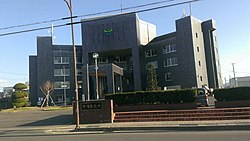Hirakawa, Aomori
|
Hirakawa 平川市 |
|||
|---|---|---|---|
| City | |||

Hirakawa city hall
|
|||
|
|||
 Location of Hirakawa in Aomori Prefecture |
|||
| Coordinates: 40°35′2.8″N 140°33′59.3″E / 40.584111°N 140.566472°ECoordinates: 40°35′2.8″N 140°33′59.3″E / 40.584111°N 140.566472°E | |||
| Country | Japan | ||
| Region | Tōhoku | ||
| Prefecture | Aomori Prefecture | ||
| Area | |||
| • Total | 346.01 km2 (133.60 sq mi) | ||
| Population (September 2015) | |||
| • Total | 32,127 | ||
| • Density | 92.8/km2 (240/sq mi) | ||
| Time zone | Japan Standard Time (UTC+9) | ||
| - Tree | Japanese black pine (Pinus thunbergii) | ||
| - Flower | Indian lotus (Nelumbo nucifera) | ||
| - Bird | Oriental turtle dove (Streptopelia orientalis) | ||
| Phone number | 0172-44-1111 | ||
| Address | 25-6 Kashiwagichō Fujiwara, Hirakawa-shi, Aomori-ken 036-0104 | ||
| Website | Official website | ||
Hirakawa (平川市 Hirakawa-shi?) is a city located in south-central Aomori Prefecture, in the Tohoku region of northern Japan.
As of September 2015, the city had an estimated population of 32,127 and a population density of 92.8 persons per km2. The total area was 346.01 square kilometres (133.60 sq mi).
Hirakawa is located in the mountains and hills to be northwest of Lake Towada. The city has a cold maritime climate characterized by cool summers and cold winters with very heavy snowfall.
The area around Hirakawa was part of the Hirosaki Domain of the Tsugaru clan during the Edo period. After the Meiji Restoration, it became part of Minamitsugaru District.
The modern city of Hirakawa was established on January 1, 2006, from the merger of the towns of Hiraka and Onoe, and the village of Ikarigaseki (all from Minamitsugaru District).
The economy of Hirakawa is primarily agricultural, with rice and apples as the predominant crops. The city government is encouraging the development of highland vegetables and a local brand of beef.
Hirakawa has nine elementary schools, four middle schools and two high schools.
...
Wikipedia



